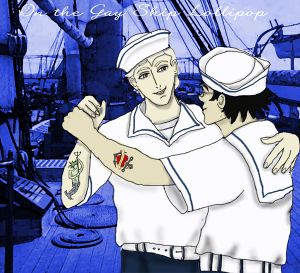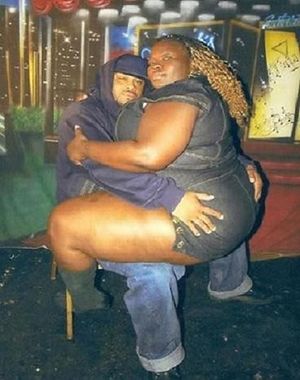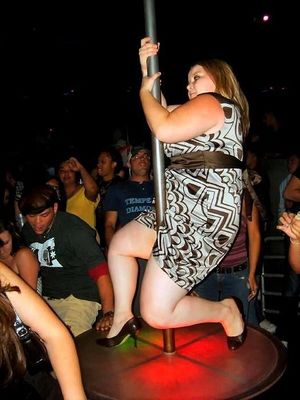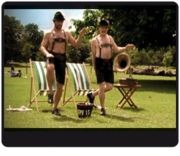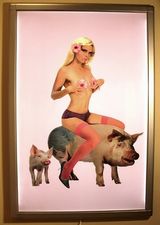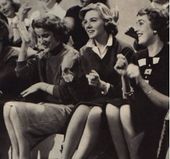Dance and Sex: Partners in time.
“ One should try everything in life except buggery and folk-dance ”
– Arnold Bax
“ One should try everything in life, especially buggery during folk-dance ”
– Oscar Wilde on life.
Dancing has been enjoyed by women and homosexuals since the dawn of time, and tolerated by straight men since they realised that it could well lead to sex - but just how did these two seemingly unrelated activities become so entwined?
Folk Dance[edit | edit source]
We have all witnessed the sensual movements of modern Latin ballroom, the passion of the Bolero, the ecstasy of Tango, but dancing and the sexual act have been opposite sides of the same coin since before coins were invented. The oldest surviving dances are the traditional folk dances preserved as part of each country's cultural heritage. Every one of these folk-traditions gives some clue as to the sexual mores of our ancestors and we would be fools to ignore the wisdom of the past.
Lapp Dancing[edit | edit source]
The Lapps (or Sami) are the last tribal people of Europe and are thought to be among the first settlers of this Northern continent. Just what do the Terpsichorean traditions of these ancient people tell us about our own past?
Between late June and mid-July, with the reindeer safely grazing the briefly flowering tundra, Lapps begin to assemble all over the Scandinavian peninsula for the Scurdifurlbattlagardtnersnikkkfretgilbretoffgar (Summer Beach Party). The men in their brightly coloured clothing line up nervously, often smoking the dried, hallucinogenic mushrooms of these Arctic latitudes while boasting of previous conquests at the previous year's Scurdifurlbattlagardtnersnikkkfretgilbretoffgar. Lapp maidens braid their hair and apply a musky perfume distilled from wolf urine that Lapp males seem almost irresistibly drawn towards..
The drums beat out an increasingly frenetic rhythm and yet no one stirs. The tribal elders begin to chant songs of fertility and incest, and still the two groups must stand on opposite sides of the room, feigning disinterest. Eventually, a Shaman stands. He blows a horn to signify the beginning of the annual festival and the dance may begin.
Within moments each man finds a chair, removes his hat and sits down, generally with a small bottle of beer that can cost up to five weeks' wages. The ladies then begin to walk slowly across the room, divesting themselves of layer after layer of seal skin and moose skin, twirling nipple-tassles woven from the tails of lemmings and finally unlacing their fox-fur thongs.
Now, often excited beyond reason, the men must remain silent. The Lapp maidens slowly apply Caribou grease to their bodies before using their buttocks to smear a small amount on the thighs of their chosen bridegroom. The lucky recipient must be careful not to give in to temptation at this point or he will be ceremonially removed from the Scurdifurlbattlagardtnersnikkkfretgilbretoffgar-centre and beaten savagely to the accompaniment of the traditional Lapp folk-song "Snidgkolpftufty nidpit klujnik" - "You can look but no touching'."
Pole Dancing[edit | edit source]
Further south, where the Winter's toll is less severe and the Summer sun plays for longer, a similar but distinct tradition has grown-up among Europe's victims of choice, the Polish people.
From Gdansk on the Baltic to Silesia in the South, young girls assemble at beer-halls in April, their hair in two plaits tied with ribbons and adorned with intricately carved wooden phalluses. Flowers or headscarves are also worn, and contraceptive sponges quickly become scarce in local pharmacies. Tight lace-up boots rather like an ice skating boot are worn but with a sharply pointed, silver heel that leaves an instantly recognisable imprint when standing on the back of the chosen groom, marking him as the possession of the dancer until the scar fades. Dresses are usually white, thin, short and cut low at the chest.
Men often wear striped trousers and tight leather posing pouches, known as "Cameos". Most men also wear a purse stuffed with small denomination bills. It is considered taboo for men to participate in Pole dancing without first consuming a large quantity of vodka. Equally, it is impermissible to attend a Pole-dance alone, ideally men should have at least four friends and should spend some time investigating which of them can roar the loudest encouragement to the shyly, virginal dancers; who can buy the most extravagant round, and which of the ornamental plant-pots is most capacious when it comes to vomiting.
One by one dancers appear on stage to briefly represent different aspects of Poland's national character. Most nights feature the aggressive, fiery character who gyrates with abandon to represent the miraculous flowering of Poland between 1569 and 1795, next comes the shy, retiring dancer who seems almost too timid to flaunt her hooters for cash and represents the disappearance of the state of Poland in the nineteenth century. Other popular characters include the cow-girl who represents Poland's contribution to the Settlement of the North American prairies and the Goth who represents The Cure's residence in Warsaw during the recording of "The Head on the Door".
Many Pole-dancers are so committed to their nation's cultural heritage that they willingly stay behind after hours offering extras to eager audience members. Interestingly, though Poles are very patriotic a frequent request is for "A bit of French".
Other European Folk-Dance Traditions[edit | edit source]
The English are famous for their inability to dance (see Billy Elliot). However, even in this repressed corner of Europe a folk-dance tradition hints at unexplored depths.
Morris Dancing is recorded as far back as 1948 and involves teams of up to twelve men who tie bells to their limbs and wave hankies in the air while beating each other's bladders with sticks. The meaning of this tradition is unknown but it is thought to involve loneliness and cider.
In Bavaria and Austria, where homosexuality is less frowned upon, Schuhplattlers can be seen in most tourist hotels. In this tradition a group of between 6 and 8 men in tightly fitting leather underwear slap their shoes in ever faster rhythms until eventually half the troupe perform a hand-stand while the remaining dancers continue the percussion on their buttocks.
Once the dance is completed, the Schuhplattlers make themselves available for hire in the hotel lobby. A bar-fee is payable to the manager for lost time and the dancer and his admirer negotiate their own rate in privacy.
The Basque people have resided in Europe almost as long as the Lapps. Their war-like ways have struck fear into the hearts of their neighbours through the centuries and yet Basque dancing is strangely restrained, involving little more than the slow movement of well-endowed maidens in restrictive underwear until either she or her audience faint. Extreme Basque dancing involves the planting of small explosive devices in railway stations, the telephoning of a bomb-threat to a National Newspaper and the production of goats' cheese to the accompaniment of accordion music while dressed only in a corset.
Beyond Folk-Dance[edit | edit source]
In an increasingly modern world folk-tradition can seem staid and old-fashioned. The young look beyond the narrow confines of their grandparents and dance has become an area for individual expression. However, despite their escape from cultural confines it seems that humans just can't resist the temptation to live-out their sexual fantasy on the dancefloor
Barn Dancing[edit | edit source]
The epicentre of barn-dancing is Louisiana where a man may marry his cousin in sure and certain knowledge that she is also his sister. In this sexually-liberated oasis there is still a need for dance, however, for this is the home of the barn-dance. Barn dancing shares some similarities with the Scottish pork-sword dance and the Irish slip-jig but away from the restrictions of the Old World, Barn-dancing has evolved into a social spectacle unique in the world.
Due to the year-long clement climate, Barn-dances may happen at any time but always involve a select group of men, generally farm-workers, congregating within a barn on a Sunday evening. Much moonshine is consumed before the "Dance" can begin but, fortified with spirit, partners are finally selected and to the reel of violins and squeal of hogs the dance gets under way. A barn-dance may last anything from three minutes to several hours depending on the vigorousness of the dancers and willingness of the stock.
Since the 1970s successive American governments have tried to abolish this home-spun tradition, citing animal cruelty, bestiality and offences against stringed instruments amongst the reasons. However, barn-dancing has thrived, evolving into line-dancing where young men inhale cocaine through a straw before sexually abusing their beast of choice.
Novelty Dances[edit | edit source]
In the late Nineteenth and twentieth centuries novelty dances became increasingly popular and this trend shows no sign of diminishing as the twenty-first century gets under way. But what do these modern takes on dance have to teach us about our increasingly sophisticated sex-lives?
The early twentieth century gave us Swing. In the 1940s, with the threat of violent death around every corner, young men and women took to exchanging partners with alacrity. After a quick two-step on the dance-floor many ladies would excuse themselves from their partner and seek out another man less exhausted from physical exertion. Inevitably, after a few minutes of gyration, the second man would be temporarily spent and the lady would once again seek a man capable of keeping up with her physical needs.
It is from Swing that we gained that staple of cheap-skate bordello-wallahs - the hand-jive. This deceptively simple dance could be enjoyed in a variety of positions; standing, seated or, most comfortably, in a prone position. The hand-jive was particualrly popular with male-dancers but many a lady has enjoyed the same experience in the privacy of her own chamber.
Other passing fads have included the banned Cha-Cha-Slide, The Jerk, the Collegiate Shag, and the Peanut-Butter Jelly Roll - oh, yes they have, Wikipedia says so.
Dance crazes come and go as the rhythms of popular music change but, despite this uncertainty, one fact remains constant - man can no more ignore the impulse to dance than he can ignore the need to share his bodily fluids.
